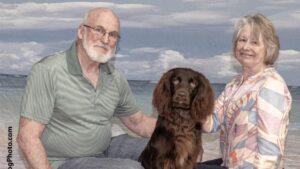
Dan & Sharon Kauzlarich | Beekauz Kennels
Dan & Sharon Kauzlarich are the breeders behind Beekauz Kennels. Read about the kennel’s beginnings, puppies, and more!

Home » Dog Breeds » Boykin Spaniel Dog Breed
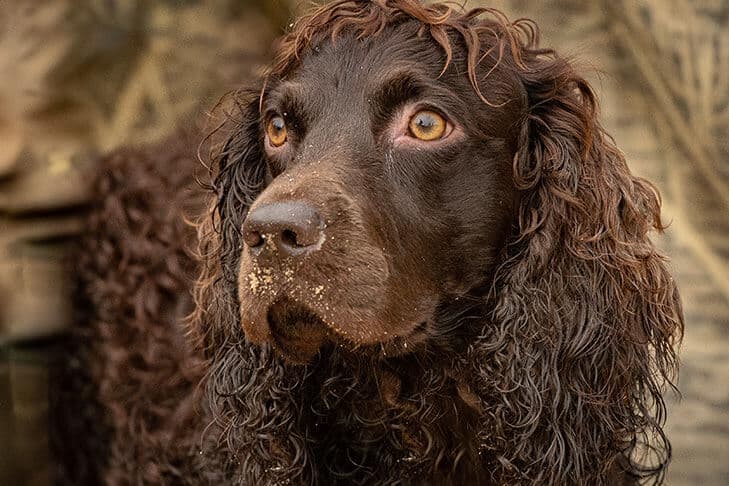
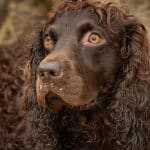
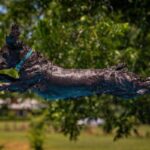
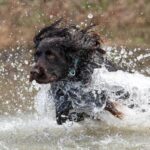
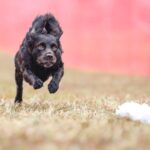
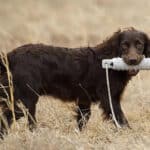
The Boykin Spaniel is a versatile and spirited hunter, renowned for its keen abilities in the field and for its friendly disposition. This breed originates from South Carolina and has become the Official State Dog. Its medium-sized frame and rich, chocolate-hued coat have garnered admiration from both hunters and families alike. Equally adept on land and in water, the Boykin possesses an unwavering enthusiasm for retrieving. Beyond its working capabilities, the breed is cherished for its affectionate nature and loyalty to its family members. Whether hunting or resting at home, the Boykin is sure to capture the hearts of many with its amiable personality and pleasing presence.
Sporting
14 – 18 inches
25 – 40 pounds
10 – 15 years
| Country of Origin | United States |
|---|---|
| Bred For | Flushing Birds, Companionship |
| Known For | Friendliness, Gentleness, Willingness, Adaptability |
| Popularity | Moderate |
| Temperament | Friendly, Eager, Lovable |
| Activities | Hunting, Running, Swimming, Conformation Shows, Dog Sports |
The Boykin Spaniel, fondly referred to as the “Little Brown Dog” of South Carolina, has a history that is as charming as the breed itself. A versatile hunting dog with a heart and head for waterfowl, the Boykin has roots that stretch deep into the American South.
The tale of the Boykin Spaniel begins in early 20th century South Carolina. The breed’s story is said to have started with a stray spaniel-type dog named “Dumpy.” Found by a man named Alexander White in the town of Spartanburg, around 1900, the little brown dog was given a home and soon showcased a natural talent for retrieving. Recognizing the dog’s abilities, White sent him to his hunting partner, Lemuel Whitaker Boykin, a man known for his expertise in training waterfowl hunting dogs.
L. W. Boykin refined and developed Dumpy’s innate skills, and from this foundation the breeding and evolution of the Boykin Spaniel began. The breed was specifically tailored for hunting wild turkeys and ducks in the Wateree River Swamp, requiring a compact, energetic dog that could handle both water and land retrieves.
The Boykin quickly endeared itself to local hunters. Its size was perfectly suited for the smaller boats frequenting the Wateree River, and its keen senses, combined with the breed’s boundless enthusiasm, made it indispensable to hunters in the area.
By the mid-20th century, the Boykin’s reputation had become more widely known, garnering even more widespread appreciation. The Boykin Spaniel Society, established to preserve the breed’s unique characteristics and heritage, played a pivotal role in promoting the breed’s many distinct qualities and its uniquely American history.
While its roots are firmly planted in hunting, the Boykin’s original role has diversified over time. Today, besides being a cherished hunting ally, the breed is also beloved as a family companion and Therapy Dog, and an eager participant in a wide variety of dog sports.
The American Kennel Club (AKC) officially recognized the Boykin Spaniel in 2009. Other major kennel clubs, such as the Fédération Cynologique Internationale (FCI) and The Royal Kennel Club (UK), have yet to give the breed their stamp of approval.
The Boykin Spaniel’s importance in South Carolina’s cultural history is clearly evident. In 1985, the state honored the breed by declaring it the Official State Dog, affirming its cherished status among South Carolinians.
Adult male Boykin Spaniels typically stand between 15.5 and 18 inches tall at the shoulder, while mature females usually range from 14 to 16.5 inches.
When it comes to weight, males generally weigh between 30 and 40 pounds, with females being typically lighter, weighing around 25 to 35 pounds.
The Boykin Spaniel is a breed that exhibits both strength and agility. It has a sturdy frame without appearing bulky. Its body length is slightly longer than its height, giving it a somewhat rectangular proportion. This length, coupled with a strong back and well-developed musculature, equips the Boykin for endurance, particularly when retrieving game. The overall substance of the breed is neither too heavy nor too light, striking a harmonious balance that showcases its athletic abilities and inherent soundness.
Texture: The coat of the Boykin Spaniel is medium in length and can range from slightly wavy to curly. This texture is not only aesthetically pleasing, it also provides the breed with protection in a wide variety of environments.
A Note About Color: The only acceptable color for a Boykin Spaniel is solid liver, a deep reddish brown that includes various shades of chocolate, from light to very dark. Some Boykins can have faint color variations due to bleaching from the sun. A small amount of white may appear on the chest, but nowhere else.
The tail of the Boykin Spaniel is an essential breed feature, indicative of the dog’s mood and enthusiasm. It is generally docked to a length of 3 to 5 inches and is set slightly below the level of the back. Undocked tails are less common in the breed. The tail is carried horizontally or slightly elevated above the level of the back, especially when the dog is alert or in motion. When the dog is in high spirits or on the move, the tail’s gentle waving motion is accentuated by a moderately dense coat that has a slight feathering.
The decision to bring a Boykin Spaniel into one’s life is to welcome a bundle of energy, intelligence, and affection. These “little brown dogs,” while endearing, do come with certain requirements and considerations that potential owners should be aware of to ensure a harmonious relationship.
The Boykin Spaniel is typically a sturdy and healthy breed, blessed with a resilient constitution. However, like all breeds and mixed breeds, the Boykin can be susceptible to specific health conditions. Prospective owners should be aware of these potential issues and work closely with a trusted breeder and veterinarian to ensure each individual dog maintains optimal health throughout its life.
Lifespan: The average lifespan of a Boykin Spaniel ranges between 10 and 15 years, but with proper care, regular check-ups, and a balanced diet, many can thrive beyond these years.
Boykin Spaniels, like any other dog, can be predisposed to certain health issues. While it’s essential to remember that not every Boykin will face these challenges, being aware of them can help owners take preventive measures and ensure early detection.
It’s important for Boykin Spaniel owners to maintain regular veterinary check-ups that can detect potential health issues early on. Choosing a reputable breeder who screens for commonly inherited health problems can also help in the search for a healthier puppy. Regular vet visits, proper nutrition, and being informed about the health concerns in the breed will all contribute to a dog’s well-being.
Boykin Spaniels are renowned for their affable nature, exuding a cheerful disposition that’s hard to resist. Their historical role as hunting companions has shaped them into alert and intelligent dogs, but it’s their affectionate demeanor that truly defines them.
For novice dog owners, a Boykin Spaniel can be a joy, as the breed is often eager to please and responsive to positive reinforcement. The sensitivity level of Boykins is moderately high, meaning they thrive on human companionship and do not respond well to harsh corrections or prolonged isolation. It’s essential to approach training with kindness and patience, understanding that the bond formed during these sessions is integral to every Boykin’s welfare.
In terms of socialization, the Boykin Spaniel usually fares well with other dogs, showcasing a playful and non-aggressive demeanor. Early socialization is crucial, as it ensures they develop positive behaviors around other animals and humans. This breed’s gentle nature typically extends to young children, making Boykins a popular choice for families. However, as with any breed, supervision during interactions between dogs and young kids is always recommended.
Their friendly approach isn’t just limited to familiar faces. Boykin Spaniels are usually welcoming toward strangers, albeit with a hint of initial caution. They might take a moment to assess a new person, but once they’re assured of benign intentions, their warm and friendly nature shines through.
The nutritional needs of a Boykin Spaniel change over the course of its life, and understanding these requirements is crucial for its overall health and well-being. Feeding a balanced diet tailored to the dog’s age, weight, activity level, and health needs can make a significant difference in its vitality and longevity.
For Boykin Spaniel puppies, it’s essential to provide a nutrient-rich puppy formula that supports their rapid growth and development. As puppies are notably active and have higher energy needs, they often require more frequent meals. Instead of feeding large portions, it’s advisable to break down their daily food intake into smaller meals spread throughout the day.
As the Boykin Spaniel transitions to adulthood, its metabolism may slow down a bit. It’s during this phase that owners should shift from puppy formula to adult dog food. Monitoring the dog’s weight and adjusting the food portions is necessary to ensure a Boykin maintains a healthy weight. Typically, an adult might consume between 1.5 to 2.5 cups of high-quality dry dog food daily. However, this amount can vary based on the dog’s activity level and individual metabolic rate.
It’s also worth noting that Boykin Spaniels, with their enthusiastic nature, can sometimes be prone to overeating. Owners should be cautious about overfeeding and refrain from giving too many treats, especially those not specifically designed for dogs.
To ascertain the most appropriate diet for a Boykin Spaniel, consulting with a veterinarian or a pet nutritionist can be invaluable. They will provide personalized recommendations that cater to the specific needs of each individual dog.
Training a Boykin Spaniel can be a delightful experience, thanks to the breed’s inherent eagerness to please and its agile mind. Historically, these dogs were trained to assist hunters in retrieving game, which honed their ability to follow commands and work cohesively with humans.
However, their responsive nature doesn’t necessarily mean training is always a walk in the park. Patience and consistency are vital. Using positive reinforcement methods, such as praise or treats, can go a long way in cementing desired behaviors. Boykins respond best to gentle, reward-based training techniques.
When it comes to vocal tendencies, the Boykin Spaniel might occasionally exhibit a tendency to bark, especially when they’re alerting their owners to someone’s arrival or if they’re bored. Early training can help to manage and even reduce excessive barking.
The breed’s intelligence is one of its most notable traits. Boykin Spaniels are quick learners, able to grasp new commands and tricks with relative ease. However, this same intelligence can sometimes lead to stubbornness if they’re not mentally stimulated. To counteract this, incorporating puzzle toys, agility training, or advanced obedience lessons can keep their minds sharp.
Wanderlust is generally not a pronounced trait in the Boykin Spaniel, but they’re still dogs, and an intriguing scent or an exciting sight might tempt them. As a safety precaution, it’s always a good idea to have a secure yard or to keep them on a leash during walks.
In terms of predatory instincts, while the Boykin Spaniel is a retriever at heart, they don’t have a particularly high drive to chase. Early socialization and training, however, can help to ensure they interact appropriately with smaller pets or wildlife.
Ensuring a Boykin Spaniel receives ample exercise is integral to its physical and emotional well-being. As Sporting Dogs, they are naturally active and thrive when they have opportunities to expend their energy in productive ways.
| Energy Level | High |
|---|---|
| Exercise Requirements | 1 Hour/Day, Daily Walks, Weekly Swimming, Regular Exercise, Playing with Another Dog, Mental Stimulation |
In terms of exercise needs, the Boykin Spaniel requires regular and consistent physical activity. A couple of daily walks, combined with some playtime in a fenced yard, can help to meet this requirement. They particularly enjoy retrieving games, making fetch a favorite activity for many within the breed.
The energy level of the Boykin Spaniel is moderately high. While they’re capable of bursts of energy during play or work, they also cherish their downtime with family members. After a good exercise session, a Boykin Spaniel is often content to simply relax and cuddle.
Intensity is a characteristic feature of this breed when they’re engaged in a task or play. Whether it’s chasing a ball, going for a swim, or participating in dog sports, a Boykin Spaniel tends to give it their all. Owners should be mindful of this intensity, ensuring the dog doesn’t overexert itself, especially in hot weather.
Lastly, they have a playful streak that endears them to both young and old. This playfulness, combined with their friendly disposition, makes them excellent companions for families, singles, and seniors alike.
Grooming a Boykin Spaniel is essential not just for aesthetic reasons but also for their overall health and well-being. The breed’s coat, characterized by a wavy to curly texture, requires regular maintenance to keep it in optimal condition.
| Coat Type | Wavy to Curly, Medium Length, Waterproof |
|---|---|
| Grooming Requirements | Weekly Brushing, Occasional Bathing, Routine Ear Cleaning, Periodic Nail Trimming, Regular Tooth Brushing |
In terms of ease of grooming, the Boykin Spaniel falls into the moderate category. Regular brushing, at least a few times a week, can help to prevent tangles and matting. This routine not only keeps the coat looking its best, it also aids in distributing the natural oils of the skin, promoting a healthy shine.
Shedding is a natural part of a Boykin Spaniel’s life. While the breed doesn’t shed heavily, there’s a consistent, light shedding that takes place throughout the year. Regular brushing can help to manage and reduce the amount of loose hair, ensuring a cleaner living environment and a healthier coat for the dog.
Apart from coat care, other grooming essentials for a Boykin Spaniel include regular ear checks and cleaning. Due to the breed’s floppy ears, Boykins can be more susceptible to ear infections. Keeping the ears clean and dry can help to prevent such issues.
Routine nail trimming, dental care, and periodic baths round out the grooming regimen. A Boykin Spaniel might need a bath every few weeks or when it gets particularly dirty. Using a dog-specific shampoo can help to maintain the coat’s natural oils and ensure healthy skin.
Preparing your living space and lifestyle for a Boykin Spaniel can be a rewarding journey, but understanding the breed’s specific needs can make the experience smoother for both the dog and owner.
For apartment living, Boykin Spaniels can adapt well, given that their exercise needs are adequately met. Their medium size and affable nature make them suitable companions for smaller living spaces. However, it’s crucial to ensure they get daily outdoor time to burn off energy and stimulate their minds.
When it comes to weather adaptability, Boykin Spaniels have a coat that offers some protection against the elements. In colder climates, their dense, wavy to curly coat provides insulation, but it’s always a good idea to be attentive during extreme cold spells and consider protective gear if necessary.
Conversely, in hot weather, Boykin Spaniels can be susceptible to overheating. Ensuring they have easy access to shade and fresh water, and limiting their exposure during peak heat hours, can help to keep them safe and comfortable.
The charm of Boykin Spaniel puppies is undeniable. These bundles of energy, with their soulful eyes and eager-to-please attitudes, can melt the hearts of anyone they meet. However, as with all puppies, Boykin Spaniels come with their own unique set of needs during their early life stages.
Bringing a Boykin Spaniel puppy home is an exciting event, but it’s also a time that demands commitment, patience, and understanding from the new owner. From the very start, it’s essential to establish a stable routine, as puppies thrive on consistency. This routine includes feeding times, potty breaks, playtime, and rest.
Socialization is a crucial aspect of every Boykin Spaniel puppy’s life. Early exposure to various people, sounds, sights, and experiences can help shape their temperament and ensure they grow up to be sociable and confident adults. Puppy classes, home visits, and controlled outings can be beneficial for their development.
Diet plays a pivotal role in a puppy’s growth. It’s vital to feed a high-quality puppy food that meets a puppy’s nutritional requirements. Keeping a watch on a pup’s weight and ensuring it is not overfed are equally essential, as obesity can lead to health issues later in life.
Teething can be a trying period for both the puppy and everyone else in the house. Providing chew toys can help alleviate some of the discomfort and protect household items from being chewed.
Lastly, early training sessions should be short, fun, and positive. Boykin Spaniel puppies, with their eager nature, can pick up on commands quickly when taught with love and positive reinforcement.
Boykin Spaniels, with their Sporting Dog lineage, are naturally inclined towards activities that challenge their physical abilities and mental acumen. Their enthusiasm and drive make them excellent participants in a wide array of dog sports and events. Here are some activities in which Boykin Spaniels excel:
The Boykin Spaniel is a versatile breed, making it suitable for a wide range of activities. Engaging the Boykin in these activities not only showcases its many talents, it also provides the mental stimulation and physical exercise the breed craves.
The Boykin Spaniel is recognized by the world’s leading registries and kennel organizations, which categorize the breed into a specific Group based on its unique characteristics. This breed is recognized worldwide under the following Group designations:
| Organization | Group Designation |
|---|---|
| AKC (American Kennel Club) | Sporting |
| UKC (United Kennel Club) | Gun Dog |
| CKC (Canadian Kennel Club) | Not Recognized |
| ANKC (Australian National Kennel Council) | Not Recognized |
| RKC (The Royal Kennel Club) | Not Recognized |
| FCI (Fédération Cynologique Internationale) | Not Recognized |
The ideal Boykin Spaniel is described by a Breed Standard that is approved by each of the world’s leading registries and kennel organizations. The Breed Standards for this breed may be found in the following links:
| Organization | Breed Standard |
|---|---|
| American Kennel Club | AKC Boykin Spaniel Breed Standard |
| United Kennel Club | UKC Boykin Spaniel Breed Standard |
| Canadian Kennel Club | Not Recognized |
| Australian National Kennel Council | Not Recognized |
| The Royal Kennel Club | Not Recognized |
| Fédération Cynologique Internationale | Not Recognized |
The Boykin Spaniel, a breed cherished for its unique history and versatile skill set, has captivated the hearts of generations of breeders, enthusiasts, and dog lovers. Many breed clubs and organizations emphasize the importance of preserving the breed’s legacy and championing its distinctive qualities.
In the United States, the Boykin Spaniel Society, established in 1977, remains at the forefront of championing the breed. The club works diligently to educate the public about the breed and promote responsible breeding practices. It also holds Retriever Field Trials as well as Upland Field Trials.
Additionally, local clubs and groups across the US celebrate the Boykin Spaniel. These local entities often organize community events, training sessions, and meet-ups, providing a platform for Boykin Spaniel breeders, trainers, and enthusiasts to connect, share experiences, and deepen their knowledge about the breed.
The breed enthusiasts’ dedication to the Boykin Spaniel extends beyond breed promotion to ensuring the welfare of individual dogs that might find themselves in less than ideal situations. Rescue groups play an invaluable role in this endeavor, providing temporary care, rehabilitation, and ultimately, finding loving forever homes for Boykin Spaniels in need.
In the United States, Boykin Spaniel Rescue, Inc. stands out as a beacon of hope for these endearing canines. This organization operates nationwide, coordinating with volunteers, foster homes, and potential adopters to secure a brighter future for Boykin Spaniels in need. The members’ tireless efforts have seen countless Boykins transition from challenging circumstances to families that cherish them.
The United Kingdom too has a network of general dog rescue organizations, such as the Dogs Trust and Royal Society for the Prevention of Cruelty to Animals (RSPCA), which could potentially take in and rehome a Boykin Spaniel, providing the same level of care and attention that is dedicated to all breeds.
Yes, Boykin Spaniels do shed. Like many breeds, Boykins have a natural shedding cycle that results in a gradual loss of dead hair. Regular grooming can help manage and reduce the amount of loose hair.
Boykin Spaniels typically have a lifespan of around 10 to 15 years. With proper care, a balanced diet, and regular veterinary check-ups, many Boykins can live a long and healthy life within this range.
No breed is truly hypoallergenic, and this includes the Boykin Spaniel. However, some individuals with pet allergies find they react less to certain breeds, but this varies from person to person. Regular grooming can help to reduce dander, which is often the primary allergen.
Boykin Spaniels are medium-sized dogs. Males typically weigh between 30 to 40 pounds, while females usually range from 25 to 35 pounds. In terms of height, adult Boykins usually stand between 14 to 18 inches tall at the shoulder.
Boykin Spaniels are not inherently quarrelsome. They are generally known for their friendly and sociable nature; however, like any breed, individual temperaments can vary, and proper socialization from a young age is crucial to ensure well-adjusted behavior.
Yes, Boykin Spaniels are born with tails. It has been a tradition in some hunting circles to dock the tails in this breed to a certain length, primarily for practical reasons related to their work in the field, but not all Boykins have their tails docked.
Absolutely! Boykin Spaniels are known for their affectionate and friendly demeanor, making them excellent family companions. Their adaptable nature and love for play can make the Boykin a great playmates for children, though supervision is always advised with younger kids.
Boykin Spaniels have a moderate tendency to bark. While they can be vocal, especially if they spot something intriguing or feel the need to alert their family, they aren’t known as incessant barkers. Training and proper stimulation can help to manage excessive barking.
The Boykin Spaniel is not the same as a Cocker Spaniel. While both breeds share some similarities due to their spaniel heritage, the Boykin was specifically bred in South Carolina for duck and turkey hunting, and is distinctly different, both mentally and physically, from its Cocker cousin.
Grooming a Boykin Spaniel involves regular brushing to remove loose hair and prevent matting, especially due to the breed’s wavy coat. It’s also important to check the ears regularly for signs of infection, given their pendulous nature. Additionally, periodic trimming, especially around the eyes, ears, and paws, will keep the Boykin looking neat and prevent potential health issues from going unnoticed.

Dan & Sharon Kauzlarich are the breeders behind Beekauz Kennels. Read about the kennel’s beginnings, puppies, and more!

Katie Eaton is the breeder behind G4K Boykin Spaniels. Read about the kennel’s beginnings, Boykin Spaniel puppies, and much more!

Insights from an Owner Handler, Penny McNiel. Penny shares her opinions on various topics about dog handling in the modern show ring.
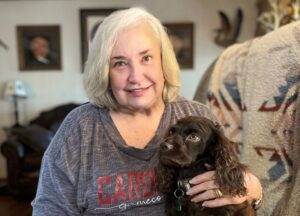
Patricia L. Watts is the breeder behind Hollow Creek Kennel. Read about the kennel’s beginnings, the sires, the dams, the puppies, and more!
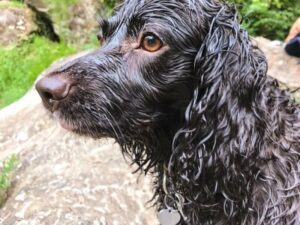
Interview with Joseph Wyant, handler of an Exemplary Companion Dog known as “Scout,” the 2022 AKC Humane Fund ACE Award Winner.
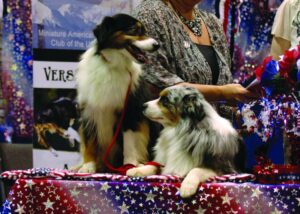
US breeders have produced a number of hearty and hungry canine originals by combining established British, European, and Asian breeds with local village dogs.
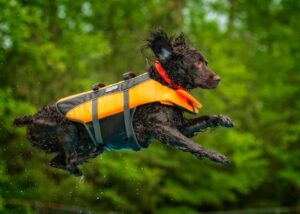
Top Reasons to Love a Boykin Spaniel – The Boykin Spaniel is unique in that no other breed of canine can claim that he is a dog…
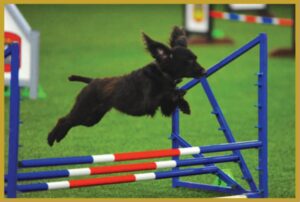
The joy of owning a Boykin Spaniel is strongest when both dog and owner work together to achieve a common goal.

Dan Sayers is the Editor-in-Chief of SHOWSIGHT digital and print publications. He received a B.S. from Drexel University where he studied interior architectural design. His professional career has allowed him to develop his planning, problem-solving, and project management skills, which were employed in the office, educational, and financial sectors. While working as a project manager, he earned a Graphic Design Certificate from the University of the Arts and began creating ads for many of America’s top-winning show dogs. Through this work, Dan became Editor-in-Chief of the nation’s first online-only dog show publication. His current role expands on this experience and broadly extends to cover the sport of dogs in Companion and Performance events as well as all aspects of Conformation.
Dan is a long-time member of the Irish Water Spaniel Club of America and is the organization’s current AKC Delegate and Archivist/Historian, as well as a club-approved Breed Mentor. From 2000-2010, he was the club’s AKC Gazette Columnist. He breeds Irish Water Spaniels under the Quiet Storm prefix and has judged the IWSCA National Specialty Sweepstakes twice. Dan is a member of the Morris and Essex Kennel Club as well as the Dog Writers Association of America, which recognized his illustrations in the award-winning canine compendium, the Encyclopedia of K-9 Terminology.
The best way to ensure a long and happy relationship with a purebred dog is to purchase one from a responsible breeder. Not sure where to begin?
Contact the National Parent Club’s Breeder Referral Program, which is listed on the AKC Breeder Referral Contacts page.
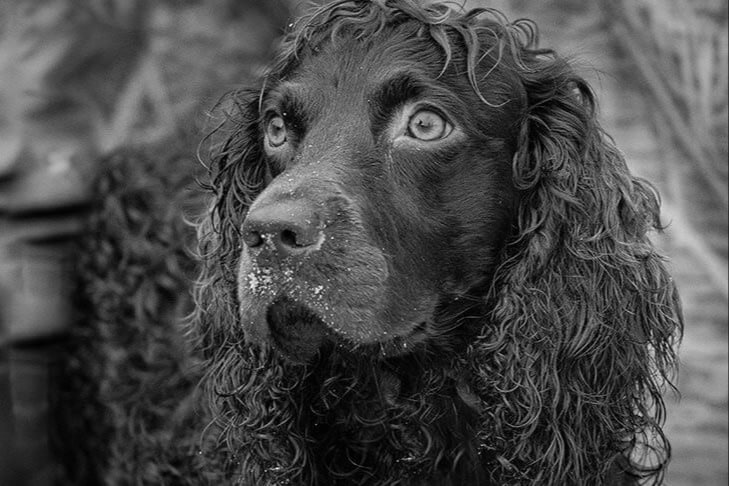

"*" indicates required fields
Showsight Magazine–the world’s most influential purebred dog publication since 1992. Each issue reaches a global audience dedicated to preserving the history and health of purpose bred dogs. Filled with award-winning editorial focused on news and insights from the dog show community, top breeders, handlers, AKC Judges, and more!